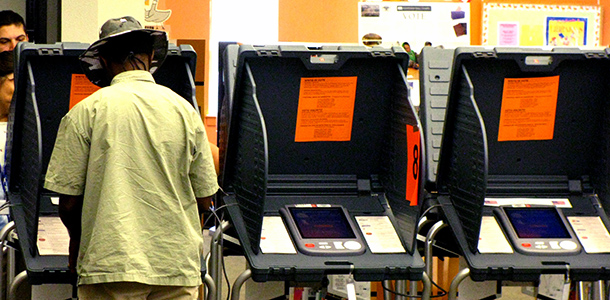
(Photo Credit: athrasher/Flickr)
Originally published in Capitol Weekly
While many of us are ready for this election season to end, we need one element of our democratic process to endure – the electoral system itself.
Campaigns and candidates make the headlines, too often for embarrassing reasons. But the administrative procedures, technology systems and people who manage elections are the essential elements of self-governance – the distribution of ballots and information, the collecting, the counting, the reporting. Like much of our public infrastructure, these systems are not always adequately maintained or updated, until they make headlines themselves.
State and county leaders in California, however, are proactively working to stay ahead of the problem – with new technologies and places to vote. Over the last year the groundwork was done to develop a new funding model for elections that could make the systems more efficient, more reliable, and more adaptable to changing demographics and lifestyles.
This kind of “progress” only excites electoral insiders. But it is the kind of proactive management required to prevent high stakes failures that undermine public confidence in government and the electoral process, like Florida’s infamous hanging chad debacle of 2000.
That administrative meltdown prompted a review of electoral systems nationwide, which led Congress to enact the Help America Vote Act (HAVA), which funded upgrades in every state.
Fourteen years later, many states are again approaching a crisis resulting from aging and deteriorating voting systems and a lack of funding to replace them. Fortunately the architecture, operations and funding of elections in California are getting serious attention. In the last year:
- An oversight hearing by the Senate Elections and Constitutional Amendments Committee hearing focused on voting technology and how to pay for it.
- The state allocated $16 million to cover additional expenses associated with an extra-large voter information guide, acknowledging the state’s responsibility to help pay for election costs historically born by counties.
- The California Association of Clerks and Election Officials (CACEO) documented the costs to counties of operating the elections process.
- California Forward assessed how counties and other state’s pay for elections, and recommended ways to construct a new funding model that would encourage efficient and reliable elections.
- Governor Jerry Brown tasked his Department of Finance to work with the Secretary of State and the Legislative Analyst to assess how elections are funded in California.
Together, these analyses, deliberations and budget decisions demonstrate the time is right for a more comprehensive reset of the state-county partnership for funding elections – one that would replace the current adversarial system, in which counties often unsuccessfully seek reimbursement from the state, with a genuine partnership.
The Department of Finance report, with the CA Fwd analysis, recognizes the numerous variables that need to be part of a comprehensive solution, including the roles and responsibilities of the state and local governments, and the increasing role of technology.
Consistent with Gov. Brown’s “subsidiarity” initiatives, state and county leaders should establish a new division of responsibilities. In this case, the state logically should assume more responsibility for financing elections for state offices and statewide ballot issues, as is done in most other states.
The need to finance new technologies creates an opportunity for the state and local agencies to agree upon incentives that could catalyze continuous improvement. For instance, state funding for new technologies could be fashioned as a match to county funds that are accrued from the savings associated with efficiency improvements – as Contra Costa County has done internally.
CA Fwd’s analysis, Investing in California’s Democracy: Building a Partnership for Performance, concluded that because technology will drive the elections process it should be the cornerstone of a new fiscal partnership between the state and even among the counties.
As often is the case, counties can and should be encouraged to innovate, with replication and adaptation to other counties. For example, given the dearth of certified vendors, open source technologies – such as those being developed in Los Angeles and San Francisco – will help to illuminate alternative paths forward for other counties.
The Department of Finance endorses the potential of incentives to encourage cost-savings by recommending a competitive grant program: “By providing incentives for process improvements, the state may be able to improve election processes while continuing to allow for independent election processes that meet the individual needs of each local government,” the report explains.
Those innovations, the DOF concluded, could include “outcome-based processes at the local government level to reduce costs,” and “regional collaboratives to increase buying power.”
In addition to efficient and reliable elections, California needs to ensure that the election systems are serving citizens as demographics, lifestyles and technological literacy evolve. A new funding model may be a perquisite, and certainly would promote steady and thoughtful adaptation.
Given this closely watched and contentious election season, there couldn’t be a better time to invest and restore trust.
James Mayer is president and CEO of CA Fwd. Caitlin Maple is research analyst for CA Fwd.

